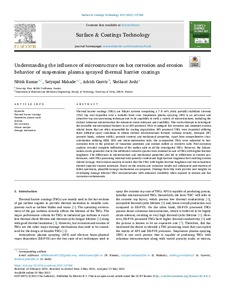Understanding the influence of microstructure on hot corrosion and erosion behavior of suspension plasma sprayed thermal barrier coatings
Kumar Nitish; Mahade Satyapal; Ganvir Ashish; Joshi Shrikant
https://urn.fi/URN:NBN:fi-fe2021093047920
Tiivistelmä
Thermal barrier coatings (TBCs) are bilayer systems comprising a 7–8 wt% yttria partially stabilized zirconia (YSZ) top coat deposited over a metallic bond coat. Suspension plasma spraying (SPS) is an advanced and attractive top coat processing technique due to its capability to yield a variety of microstructures, including the desired columnar microstructure for enhanced strain tolerance and durability. This work attempts to investigate the desirable microstructural features in an SPS processed TBCs to mitigate hot corrosion and minimize erosion related losses that are often responsible for coating degradation. SPS processed TBCs were deposited utilizing three different spray conditions to obtain distinct microstructural features (column density, interpass [IP] porosity bands, column width), porosity content, and mechanical properties. Apart from comprehensive characterization utilizing SEM, XRD and micro-indentation tests, the as-deposited TBCs were subjected to hot-corrosion tests in the presence of vanadium pentoxide and sodium sulfate as corrosive salts. Post-corrosion analysis revealed complete infiltration of the molten salts in all the investigated TBCs. However, the delamination cracks generated due to the infiltrated corrosive species were minimal in case of TBCs with higher fracture toughness. The differences in microstructure and mechanical properties also led to differences in erosion performance, with TBCs possessing minimal total porosity content and high fracture toughness best resisting erosion related damage. Post-erosion analysis revealed that the TBCs with higher fracture toughness and micro-hardness showed superior erosion resistance. Based on the erosion and corrosion results and subsequent post-mortem of failed specimens, plausible damage mechanisms are proposed. Findings from this work provide new insights on developing damage tolerant TBCs microstructures with enhanced durability when exposed to erosion and hot corrosion environments.
Kokoelmat
- Rinnakkaistallenteet [27094]
